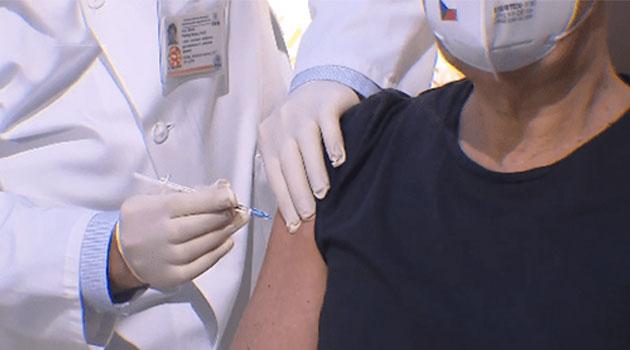The other Czech pandemic: Disinformation about anti-COVID vaccination. Romea.cz refutes the most frequent hoaxes and manipulations

It is becoming an iron-clad rule of thumb in the Czech Republic that each new piece of information reported these days is accompanied by 10 pieces of disinformation. In the case of the events around the COVID-19 disease, that is doubly true.
Different hoaxes and manipulations used to pop up before, but those authoring them were doing so for their own amusement; today the aftermath of people believing hoaxes is much more dangerous and could even destabilize or hamstring the entire society, above all by being spread through various social media. Every day, the common social media user is flooded with an unbelievable amount of information, and therefore frequently loses the motivation to verify any of it, becoming a consumer who takes in all that is served up through such channels.
The high effectiveness of the hoaxes and manipulations that then create our modern myths is startling. After all, today it is very easy to verify information on the Internet from multiple sources and to familiarize oneself with the commentaries of generally recognized experts.
A torrential disinformation tsunami has also been flooding us in association with the vaccinations against the COVID-19 disease, just as they are beginning. Below is an overview of several popular pieces of disinformation about these vaccinations on the Czech Internet.
Myth #1: In the video footage of vaccinations, the syringes “don’t have needles”
One such manipulated video that is typical of this hoax uses footage from the BBC of health care personnel being vaccinated in Britain. After the syringe holding the vaccine makes contact with the patient’s arm and is then removed, the needle is described as “missing” from the syringe.
The problem is that this video is mostly being shared along with a commentary labeling the footage as evidence of “vaccination fraud”. The footage shows no such thing, though.
The most modern version of the syringes available for such injections are being used for these vaccinations. After the patient is vaccinated, the syringe is designed to retract the needle back inside itself for disposal.
Thanks to this technology, the risk of health care workers injuring themselves with the needle is significantly reduced. You can see how such a syringe works in this video from its manufacturer:
Myth #2: Nurse Tiffany Dover died after being vaccinated against COVID-19
In the USA, Nurse Tiffany Dover felt woozy after being injected with the Pfizer vaccine on 19 December, but after collapsing during the press conference that was held around the event of the vaccination, she quickly recovered and continued answering questions. The nurse related that she sometimes experiences such states.
“Whenever I feel pain, I frequently become lethargic,” Dover admitted. She suffers from a condition called vasovagal syncope.
This kind of physical reaction to seeing blood or sensing pain is not uncommon. However, conspiracy theorists are not satisfied with that explanation, and the infamous online project called “Open Your Mind” (Otevři svou mysl) continues to claim that Dover died after being vaccinated.
The hoaxsters allege that records from the database of deaths are evidence of her supposed demise. In response to such rumors, Catholic Health Initiatives Memorial Hospital in Chattanooga, Tennessee published a brief video to their YouTube channel featuring Dover surrounded by many colleagues on 21 December to demonstrate that she is fine:
Myth #3: Czech Prime Minister Babiš wasn’t really vaccinated or was injected with a “placebo”
Conspiracy theories have also developed around the recent vaccination of the Czech PM. A Facebook account belonging to a user called “Zdenda Milimetr Rajman” alleges that in the footage of the vaccination, the doctor performing the injection covers the injection site with his other hand so it cannot be seen.
From the footage of the procedure, however, it is apparent that the doctor did not cover the injection site until after it was absolutely clear that the needle had penetrated the PM’s muscle. In the discussions beneath the Facebook post alleging otherwise, the baseless theory that the PM was injected with a “placebo” also appears.
Myth #4: It’s “extraordinary” that while there is no medicine to cure COVID-19, we have a vaccine against it
Opponents of vaccination frequently express astonishment at the idea that we have vaccinations against COVID-19 but no medicine to cure it; in reality, though, this is not an isolated example of such a situation. There are many diseases for which this is the case.
Take chicken pox, for example, or measles, mumps, rabies and rubella. For all those diseases we have just one kind of prevention – vaccination.
We know how to treat the symptoms of these diseases (the high fevers they entail) but not the disease itself. For the time being there is no effective medicine against COVID-19, but its symptoms are being treated, and it is recommended that we all support our immune systems by consuming vitamins.
In addition, doctors are testing the effectiveness of the broadest possible range of drugs on COVID-19, and they are also experimenting with giving patients what is called reconvalescent plasma from donors. By the way, it is exactly vaccination that can significantly increase the number of donors of reconvalescent plasma, because there will be a much higher number of people with a larger number of antibodies to COVID-19 available to donate.
Myth #5: The vaccine allegedly has “3 000” (or “3 150”) unwanted side effects
Now that the across-the-board vaccinations with the Pfizer vaccine are beginning, numerous attempts to discredit the vaccine are appearing, and one such bid was made on the Czech Internet through the “Open Your Mind” web portal and then through the Aeronet website. Both of these websites cite an alleged “3 150 unwanted side effects” (Aeronet rounded the number down to “3 000”) and allege that people who have received the vaccine “were unable to perform common daily activities, were unable to work, and required the care of a doctor or medical professionals.”
Based on such an interpretation of the available data, the Pfizer vaccine would actually “not be very safe”, or it would even be downright ineffective. The reality is different, though.
The conspiracy theorists have misused a small segment of a lecture in the US by Thomas Clark, who is an expert, about the Pfizer vaccine results. Clark was reporting on the findings of the V-Safe system, which tracks undesirable side effects among persons vaccinated with the Pfizer material.
That system functions on the basis of daily questionnaires completed by the vaccinated individuals. It captures all incidents reported by the vaccine users, including incidents not associated with their immunization.
All the reports are then investigated by the Vaccine Adverse Event Reporting System (VAERS) and subsequently validated (which is what Clark’s lecture was about). The number “3 150” is just the total number of incidents reported – prior to their being investigated and either validated or invalidated.
In his lecture, Clark says that after validating all those reports, there were just six confirmed cases of anaphylactic reaction to receiving the vaccine. That fact is one the conspiracy theorists will not communicate to you.
Some facts about the history of vaccinations in Czechoslovakia
It is certainly appropriate to remind ourselves of the history of vaccinations on the territory of the former Czechoslovakia. In Bohemia, vaccination against smallpox began in 1821 on the basis of an Imperial document (the territory was then part of the Austrian Empire).
By the close of the 19th century, vaccination against rabies was added. In 1919, compulsory vaccination and revaccination against smallpox was introduced in Czechoslovakia, which ended in 1980 in connection with the eradication of smallpox (Variola major and Variola minor) worldwide.
Other vaccines gradually began to be used in Czechoslovakia, for example, diptheria vaccine in 1946. A significant decrease in morbidity and zero mortality was achieved for the disease of pertussis after the start of nationwide vaccination against it in 1951.
In the year 1950, more than 60 000 cases of pertussis were recorded in Czechoslovakia, but four years after introducing vaccination against it, that number was halved, and by 1960 there were just approximately 5 500 cases recorded. From the second half of the 1970s, the number of such cases were just a few dozen annually, with a maximum of 187 cases reported in the year 2000.
Czechoslovakia was the first state in the world to scientifically demonstrate nationwide eradication of contagious polio in children; after introducing compulsory vaccination for all against the disease in 1960, the last 33 cases of that infection were recorded. Similar results were achieved here after introducing across-the-board vaccinations against measles, rubella, tetanus and tuberculosis.
